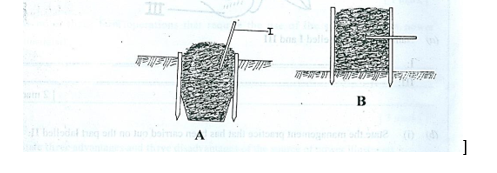Question 4
The diagrams below show methods of compost making. Study them and answer the questions that follow.

(a)
(i) Name the methods of compost making shown in diagrams A and B. [2 marks]
(ii) Which of the methods is recommended for use in high rainfall areas? [1 mark]
(iii) Which of the methods is recommended for use in high rainfall areas? [1 mark]
(b) State one role of each of the following materials in compost making:
(i) urine;
(ii) animal dung;
(iii)water. [3 marks]
(c) Give three reasons for turning compost materials during their preparation. [3 marks]
(d)
(i) Name the object in the diagram labeled I. [1 mark]
(ii) State the use of the object in compost making. [1 mark]
(e) State the reason why freshly prepared compost should not be applied to crops. [2 marks]
Observation
This question was poorly attempted by the candidates. In 4(a)(i-iii), most of the candidates were unable to name the methods of compost making shown in the diagrams as well as recommend a method of compost making in high rainfall areas with reason. Further to this, majority of the candidates could neither state the roles of urine, animal dung and water in compost making nor give reasons for turning compost materials during their preparation as required in 4(b-c).
Finally, most of the candidates could neither state the use of the tester in compost making nor state the reason why freshly prepared compost should not be applied to crops.
The expected answers include:
4. (a)
(i)Name of methods of compost making
A: Pit method
B: Stack/Heap method
(ii)Method recommended for use in high rainfall areas
Method B: Stack/Heap method
(iii)Reason
Loss of nutrients to rain water using the stack/heap method in high rainfall
areas is insignificant compared to similar losses associated with the pit method
in such areas
(b)
(i) Role of materials in compost making
(i) Urine: To moderate the pH of the compost/decomposing materials
(ii) Animal dung: To introduce bacteria for the decomposition of the compost/Facilitate the decomposition process
(iii) Water: To provide a moist environment for the agents of decomposition (e.g bacteria/micro-organisms)/ Enhance the decomposition process
(c) ) Reasons for turning compost materials
- To add air to the compost for aerobic bacteria/to increase microbial activities
- To prevent the undesirable activities of anaerobic bacteria
- To ensure uniform decomposition of the compost materials
- To make the environment moist for chemical activities on the materials on top
- To speed up the decomposition process
- To ensure a well prepared/finished compost
(d)
(i) Common name of the object
Tester
(ii) Use of the object in compost making
- To confirm/test whether the compost materials are undergoing decomposition
- To check/determine the pH of the compost
- To determine the level of decomposition of the compost
(e) The reason why freshly prepared compost should not be applied to crops
Because freshly prepared compost still undergoes decomposition accompanied
by the release of heat which will burn the roots of growing crops.
